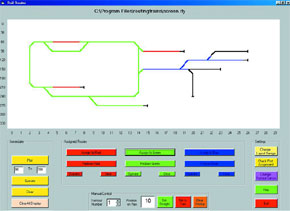Rail Router
model train routing with a PC

This is a MEMBER ONLY article. You need a subscription to read this article.
- Unlimited access to online Member Only articles
- 3 new editions Elektor Magazine (digital)
- More than 5000 Gerber files
- 20% member discount on e-books (at elektor.com)
- 10% member discount on Products (at elektor.com)
Available from €5.33 per month.
What is Members Only
Elektor is committed to providing high-quality content on electronics, catering to tens of thousands of paying members. As part of this commitment, Elektor has launched Premium, an initiative that offers exclusive online articles to members sometimes even before they appear in the magazine.
Every day, members can access in-depth articles that showcase the best of Elektor's premium content.
This initiative aims to reward members with early access. Once logged in, members can easily enjoy this exclusive content and engage in discussions about featured projects. While Premium adds to the existing resources available, Elektor will continue to provide a wealth of free information.
Join the Elektor community today to take advantage of Premium and other benefits!
Materials
Gerber file
CAM/CAD data for the PCB referred to in this article is available as a Gerber file. Elektor GREEN and GOLD members can exclusively download these files for free as part of their membership. Gerber files allow a PCB to be produced on an appropriate device available locally, or through an online PCB manufacturing service.
Elektor recommends the Elektor PCB Service service from its business partner Eurocircuits or AISLER as the best services for its own prototypes and volume production.
The use of our Gerber files is provided under a modified Creative Commons license. Creative Commons offers authors, scientists, educators and other creatives the freedom to handle their copyright in a more free way without losing their ownership.
Component list
Resistors:
R1 = 4kOhm 7R2,R3,R4 = 10kOhm
R5 = 47kOhm
Capacitors:
C1,C2 = 22pF
C3-C7,C9 = 10µF 25V radial
C8,C11,C12 = 100nF
C10 = 1µF 16V radial
Semiconductors:
IC1 = PIC16F877-20/P, programmed, order code 030403-41
IC2 = MAX232
IC3* = 74HCT241
IC4 = 7805
Miscellaneous:
JP1,JP2 = jumper
K2-K16 = 3-way SIL pinheader
K17 = 9-way sub-D socket (female) angled pins, PCB mount
K18* = 10-way boxheader
K19 = 2-way PCB terminal block, lead pitch 5mm
X1 = 8MHz quartz crystal
PCB, order code 030403-1 (see Readers Services page)
Disk, all project software (PIC & PC), order code 030403-11 or Free Download
* only required when a Slave Router is connected
Slave Router
Resistors:
R2,R3 = 10kOhm
R5-R8 = 47kOhm
Capacitors:
C1,C2 = 22pF
C9 = 10µF 25V radial
C12 = 100nF
C10 = 1µF 16V radial
Semiconductors:
T1 = BC550
IC1 = PIC16F877-20/P, programmed, order code 030403-41
IC4 = 7805
Miscellaneous:
K1-K16 = 3-way SIL pinheader
K18 = 10-way boxheader
K19 = 2-way PCB terminal block, lead pitch 5mm
S1 = 3- or 4-way DIP switch
X1 = 8MHz quartz crystal
PCB, order code 030403-1 (see Readers Services page)



Discussion (0 comments)